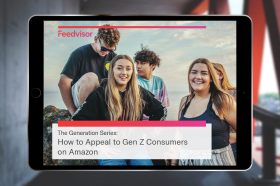Resources - Blog
5 Reasons Video Should Be a Priority in Your Marketing Strategy

Stay on top of the latest e-commerce and marketplace trends.
From YouTube and TikTok to Instagram and Amazon Live, video content continues to appear across all corners of the internet and social media channels. Video marketing — which HubSpot defines as “using videos to promote and market your product or service, increase engagement on your digital and social channels, educate your consumers and customers, and reach your audience with a new medium” — is becoming a critical element of any holistic marketing strategy.
At the Interactive Advertising Bureau (IAB) Direct Brand Summit 2019, Google’s Head of Industry for D2C Retail Jodi Goldberg said YouTube reaches more 18- to 49-year-old consumers than all television networks combined. How can you leverage this exposure to bolster the visibility of both your brand and products?
In this post, discover five reasons that video should be an integral aspect of your overall marketing strategy in order to connect with users, drive tangible business results, and measure performance.
1. You can create an engaged community and meet your customers and prospects where they are.
With more than 2 billion monthly visitors on YouTube, incorporating video into your marketing strategy can help you cultivate a community that people want to be a part of and will advocate through social proof in the future. You need to explicitly understand the shift taking place in content consumption and leverage video to get in front of customers and prospects that may exclusively be finding products through video formats.
2. You can connect with shoppers at all stages of the purchase journey.
Video can be used to broaden exposure and brand awareness, expand your brand’s influence in a new channel, and untap a network of net new customers. Over 40% of global shoppers say they have purchased products they first discovered on YouTube. From recorded webinars and knowledge-based videos to customer video testimonials and live demonstrations, video enables a more personalized and credible customer experience. You can, for example, use an introductory video about your product or service to build trust or a case study to help a user convert.
It is clear that advertisers are integrating video throughout the entire sales funnel, as it can help generate awareness and inform purchase decisions — 90% of customers say videos help make these decisions. Not only has video made the entire buying process more catered to consumers’ wants and needs, but it also allows advertisers to engage with and convert prospects throughout the entire purchase journey — across intent, engagement, remarketing, conversion, and advocacy.
3. You can use video to find creative ideas for future campaigns by leveraging insights and trends.
Look at other videos that are trending across the platforms that you use for your business and keep your finger on the pulse of new applications, such as TikTok, that consumers are using to create and absorb video content. With 71% of consumers watching more video online than they were a year ago, it will remain pivotal that you track and absorb video content yourself so you can effectively inform your video marketing strategy.
4. You can use video to showcase authentic storytelling elements and techniques for your brand.
Use video to communicate your brand’s value proposition and purpose and build awareness to attract your target demographic. High-quality video content can increase brand engagement and pique interest, which can result in traffic and conversion on your own website, Amazon store, or other channel. Amazon Live, for example, enables you to engage with customers in real time and infuses interactive live video into your selling experience while simultaneously promoting product discovery.
5. Video is captivating, easily shareable, and its popularity is only increasing.
Users are growing to expect video. If you are not creating and leveraging video, you run the risk of being falling behind the competition. Make sure you showcase your video content in easily shareable clips for social media, especially given that social video generates 1200% more shares than text and image content combined.
Continue to build on your existing video strategy to establish a cadence for distribution and have a plan in place for how video aligns and links back to your business objectives. Whether it is filling out a form, requesting a demo, or learning more, for example, you should know what action you want the audience to take after engaging with your video so you can monitor success rates.
Final Thoughts
By 2021, 13% of all internet traffic is slated to consist of live video. If you are a brand or retailer selling via e-commerce channels, have a brainstorming session with your team to determine the budget and identify the types of video formats that will have the most impact, drive the most ROI, and generate high-quality leads for your business.
Learn what Feedvisor can do for your business.
When you partner with Feedvisor, you automatically receive access to our true, AI-driven technology and hands-on team of e-commerce experts. Contact one of our team members today to learn more about our end-to-end solution for brands and large sellers on Amazon, Walmart, and e-marketplaces.



